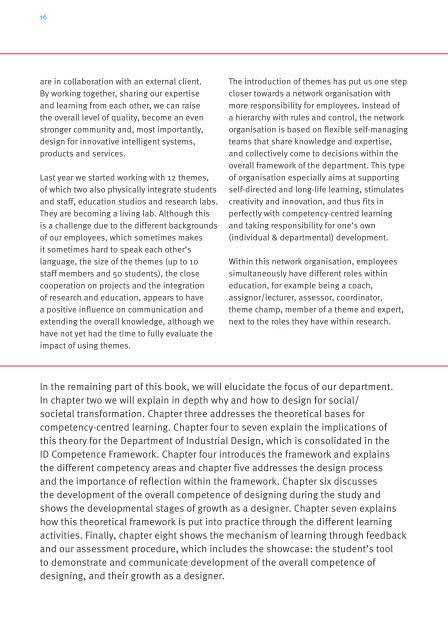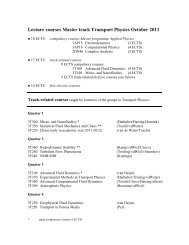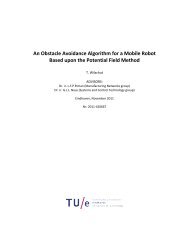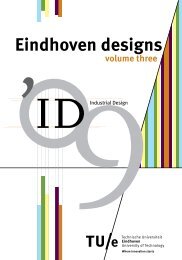Education guide 'Eindhoven designs' - Technische Universiteit ...
Education guide 'Eindhoven designs' - Technische Universiteit ...
Education guide 'Eindhoven designs' - Technische Universiteit ...
You also want an ePaper? Increase the reach of your titles
YUMPU automatically turns print PDFs into web optimized ePapers that Google loves.
16<br />
are in collaboration with an external client.<br />
By working together, sharing our expertise<br />
and learning from each other, we can raise<br />
the overall level of quality, become an even<br />
stronger community and, most importantly,<br />
design for innovative intelligent systems,<br />
products and services.<br />
Last year we started working with 12 themes,<br />
of which two also physically integrate students<br />
and staff, education studios and research labs.<br />
They are becoming a living lab. Although this<br />
is a challenge due to the different backgrounds<br />
of our employees, which sometimes makes<br />
it sometimes hard to speak each other’s<br />
language, the size of the themes (up to 10<br />
staff members and 50 students), the close<br />
cooperation on projects and the integration<br />
of research and education, appears to have<br />
a positive influence on communication and<br />
extending the overall knowledge, although we<br />
have not yet had the time to fully evaluate the<br />
impact of using themes.<br />
The introduction of themes has put us one step<br />
closer towards a network organisation with<br />
more responsibility for employees. Instead of<br />
a hierarchy with rules and control, the network<br />
organisation is based on flexible self-managing<br />
teams that share knowledge and expertise,<br />
and collectively come to decisions within the<br />
overall framework of the department. This type<br />
of organisation especially aims at supporting<br />
self-directed and long-life learning, stimulates<br />
creativity and innovation, and thus fits in<br />
perfectly with competency-centred learning<br />
and taking responsibility for one’s own<br />
(individual & departmental) development.<br />
Within this network organisation, employees<br />
simultaneously have different roles within<br />
education, for example being a coach,<br />
assignor/lecturer, assessor, coordinator,<br />
theme champ, member of a theme and expert,<br />
next to the roles they have within research.<br />
In the remaining part of this book, we will elucidate the focus of our department.<br />
In chapter two we will explain in depth why and how to design for social/<br />
societal transformation. Chapter three addresses the theoretical bases for<br />
competency-centred learning. Chapter four to seven explain the implications of<br />
this theory for the Department of Industrial Design, which is consolidated in the<br />
ID Competence Framework. Chapter four introduces the framework and explains<br />
the different competency areas and chapter five addresses the design process<br />
and the importance of reflection within the framework. Chapter six discusses<br />
the development of the overall competence of designing during the study and<br />
shows the developmental stages of growth as a designer. Chapter seven explains<br />
how this theoretical framework is put into practice through the different learning<br />
activities. Finally, chapter eight shows the mechanism of learning through feedback<br />
and our assessment procedure, which includes the showcase: the student’s tool<br />
to demonstrate and communicate development of the overall competence of<br />
designing, and their growth as a designer.

















